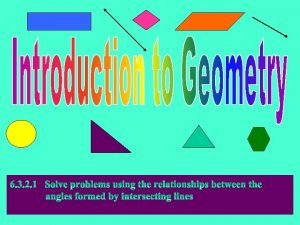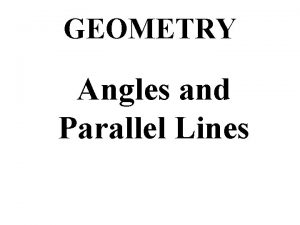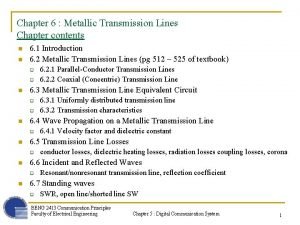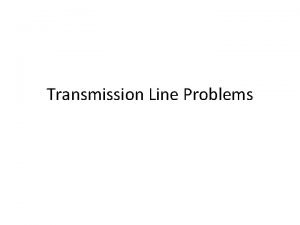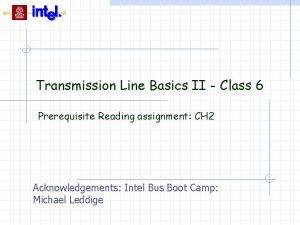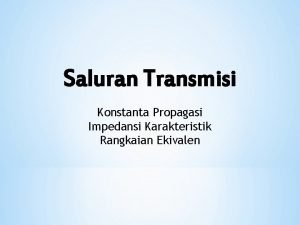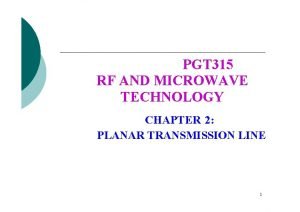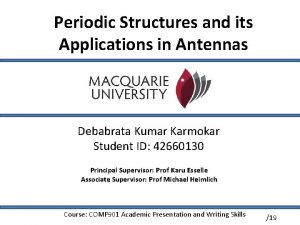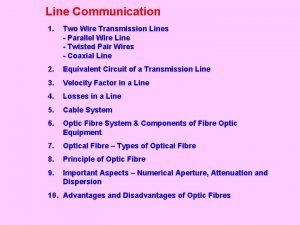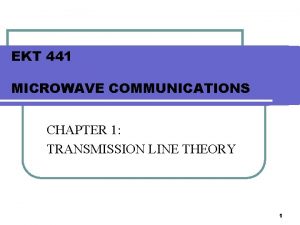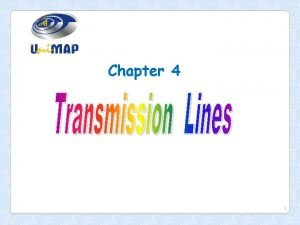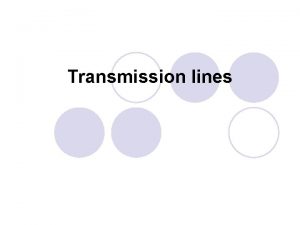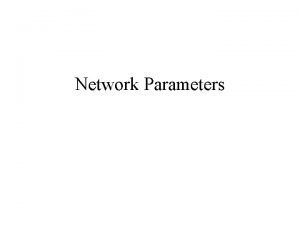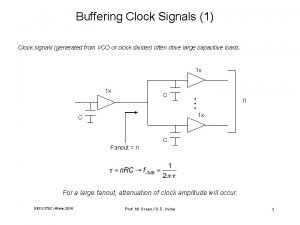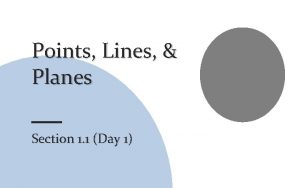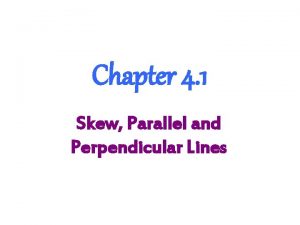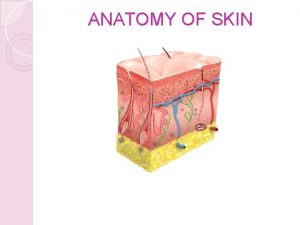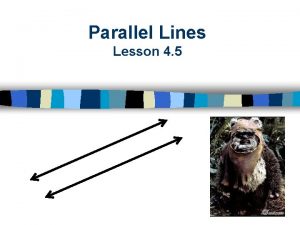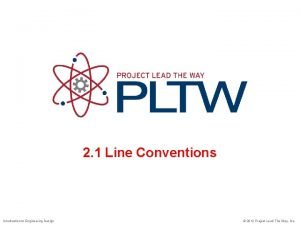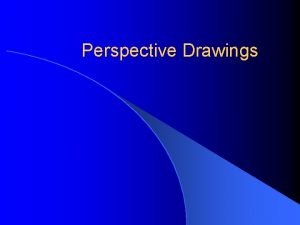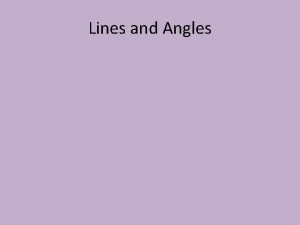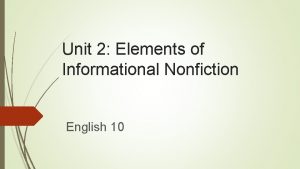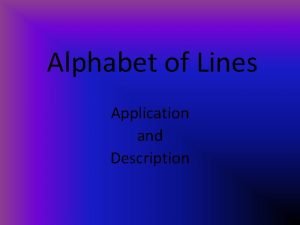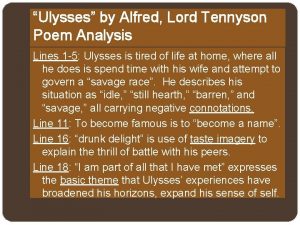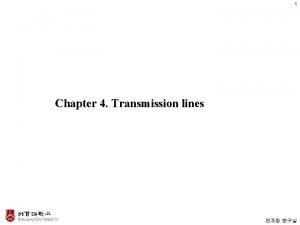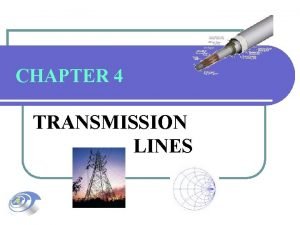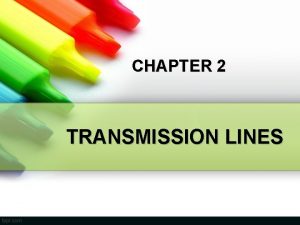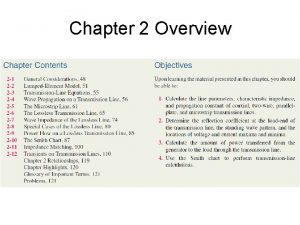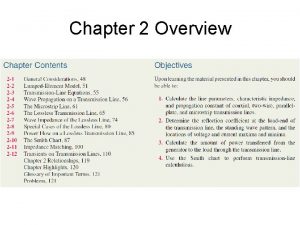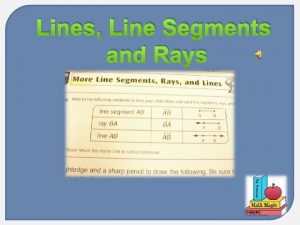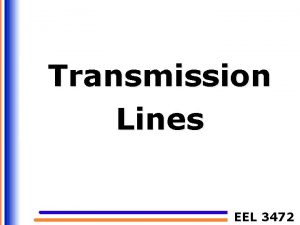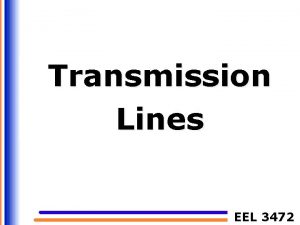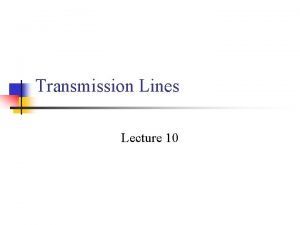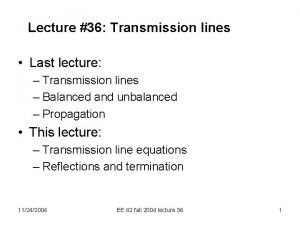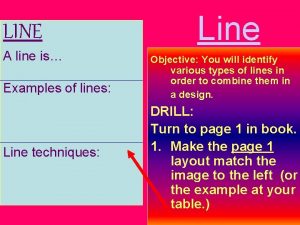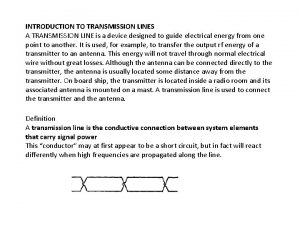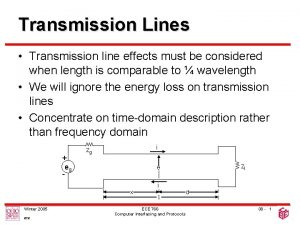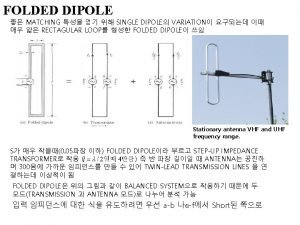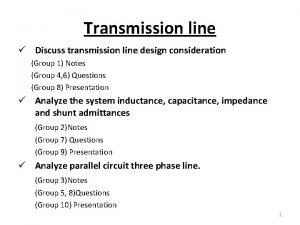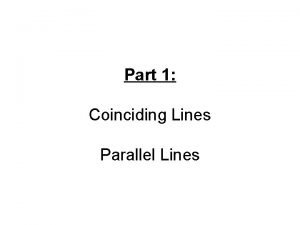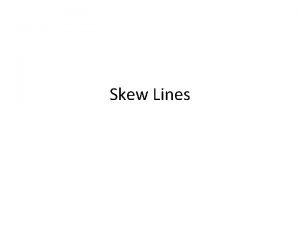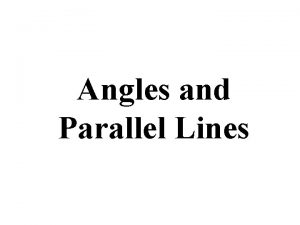Chapter 4 1 Transmission Lines A transmission line






























- Slides: 30

Chapter 4 1

Transmission Lines A transmission line connects a generator to a load Transmission lines include: • Two parallel wires • Coaxial cable • Microstrip line • Optical fiber • Waveguide • etc.

Example of TEM Mode Electric Field E is radial Magnetic Field H is azimuthal Propagation is into the page

Transmission line equations Telegraphist’s Equation is used to determine the basic characteristics for transmission line, which are: Complex propagation constant, γ α – the real part of γ - attenuation constant, unit: Np/m β – the imaginary part of γ - phase constant, unit: rad/m

Transmission line equations The characteristic impedance of the line, Z 0 : Phase velocity of propagating waves: where f = frequency (Hz) λ = wavelength (m)

Using the relation properties between μ, σ, ε : Wavelength, λ Where εr = relative permittivity of the insulating material between conductors

Lumped- element model • A transmission line is represented by a parallelwire configuration regardless of the specific shape of the line, i. e coaxial line, two-wire line. • Lumped element circuit model consists of four basic elements called ‘the transmission line parameters’ : R’ , L’ , G’ , C’.

Lumped-element transmission line parameters:

Lumped- element model

5 -2 Lumped-Element Model • Lumped-element circuit model consists 4 transmission line parameters: 1. R’ (Ω/m) 2. L’ (H/m) 3. G’ (S/m) 4. C’ (F/m)

5 -2 Lumped-Element Model • In summary, • All TEM transmission lines share the relations:

5 -3 Transmission-Line Equations • Transmission line equations in phasor form is given as

5 -4 Wave Propagation on a Transmission Line • The wave equation is derived as Complex propagation constant • γ has real part α (attenuation constant) and imaginary part β (phase constant).

5 -4 Wave Propagation on a Transmission Line • Characteristic impedance Z 0 of the line is • Phase velocity for propagating wave is where f = frequency (Hz) λ = wavelength (m)

Example 5. 1 Air Line An air line is a transmission line for which air is the dielectric material present between the two conductors, which renders G’ = 0. In addition, the conductors are made of a material with high conductivity so that R’ ≈0. For an air line with characteristic impedance of 50 and phase constant of 20 rad/m at 700 MHz, find the inductance per meter and the capacitance per meter of the line.

Solution 5. 1 Air Line The following quantities are given: With R’ = G’ = 0, The ratio is given by We get L’ from Z 0

5 -5 The Lossless Transmission Line • Low R’ and G’ for transmission line is called lossless transmission line. • Using relation properties,

5 -5 The Lossless Transmission Line • Wavelength is given by • where εr = relative permittivity For the lossless line, there are 2 unknowns in the equations for the total voltage and current on the line.

5 -5. 1 Voltage Reflection Coefficient • The relations for lossless are • A load that is matched to the line when ZL = Z 0, Γ = 0 and V 0−= 0.

Example 5. 2 Reflection Coefficient of a Series RC Load A 100 -Ω transmission line is connected to a load consisting of a 50 -Ω resistor in series with a 10 -p. F capacitor. Find the reflection coefficient at the load for a 100 -MHz signal.

Solution 5. 2 Reflection Coefficient of a Series RC Load The following quantities are given The load impedance is Voltage reflection coefficient is

Smith Chart • Smith chart is used to analyze & design transmission line circuits. • Reduce tedious work of complex mathematics in high frequency transmission line problems. • Plotted on the complex reflection coefficient plane in two dimensions real and imaginary(normalized impedance). • Impedances on Smith chart are represented by normalized value, z. L for example:

5 -9 Smith Chart • Impedances represented by normalized values, Z 0. • Reflection coefficient is • Normalized load admittance is

Voltage reflection coefficient • Voltage reflection coefficient, Γ – the ratio of the amplitude of the reflected voltage wave, V 0 - to the amplitude of the incident voltage wave, V 0+ at the load. • Hence,

Standing Waves • Interference of the reflected wave and the incident wave along a transmission line creates a standing wave. • Constructive interference gives maximum value for standing wave pattern, while destructive interference gives minimum value. • The repetition period is λ for incident and reflected wave individually. • But, the repetition period for standing wave pattern is λ/2.

Standing Waves • For a matched line, ZL = Z 0, Γ = 0 and = |V 0+| for all values of z.

Standing Waves • For a short-circuited load, (ZL=0), Γ = -1.

Standing Waves • For an open-circuited load, (ZL=∞), Γ = 1. The wave is shifted by λ/4 from short-circuit case.

Voltage standing wave ratio • VSWR is the ratio of the maximum voltage amplitude to the minimum voltage amplitude: • VSWR provides a measure of mismatch between the load and the transmission line. • For a matched load with Γ = 0, VSWR = 1 and for a line with |Γ| = 1, VSWR = ∞.

Input impedance of a lossless line • The input impedance, Zin is the ratio of the total voltage (incident and reflected voltages) to the total current at any point z on the line. • or
 Line vw and line xy are parallel lines
Line vw and line xy are parallel lines Examples of parallel lines
Examples of parallel lines Classification of surveying
Classification of surveying Metallic transmission lines
Metallic transmission lines Lossless transmission line examples
Lossless transmission line examples Transmission line basics
Transmission line basics Rangkaian ekivalen saluran transmisi
Rangkaian ekivalen saluran transmisi Microstrip transmission line
Microstrip transmission line Microstrip transmission line
Microstrip transmission line Mechanical considerations of transmission line
Mechanical considerations of transmission line Two wire line communication involves
Two wire line communication involves Electrical length
Electrical length Attenuation constant formula
Attenuation constant formula Rigid air filled coaxial cable
Rigid air filled coaxial cable Abcd short
Abcd short Lossless transmission line
Lossless transmission line Worksheet 1-1 points, lines, and planes day 1
Worksheet 1-1 points, lines, and planes day 1 Characteristics of skew lines
Characteristics of skew lines Kraissl lines vs langer lines
Kraissl lines vs langer lines Parallel lines lesson
Parallel lines lesson Line conventions in engineering drawing
Line conventions in engineering drawing Horizontal line art definition
Horizontal line art definition Define parallel lines and intersecting lines
Define parallel lines and intersecting lines Elements of informative nonfiction
Elements of informative nonfiction 14 line sonnet
14 line sonnet Alphabet of lines application
Alphabet of lines application Chapter 19 disease transmission and infection prevention
Chapter 19 disease transmission and infection prevention Chapter 19 disease transmission and infection prevention
Chapter 19 disease transmission and infection prevention Chapter 15:5 sterilizing with an autoclave
Chapter 15:5 sterilizing with an autoclave Chapter 19 disease transmission and infection prevention
Chapter 19 disease transmission and infection prevention Ulysses poem analysis line by line
Ulysses poem analysis line by line
